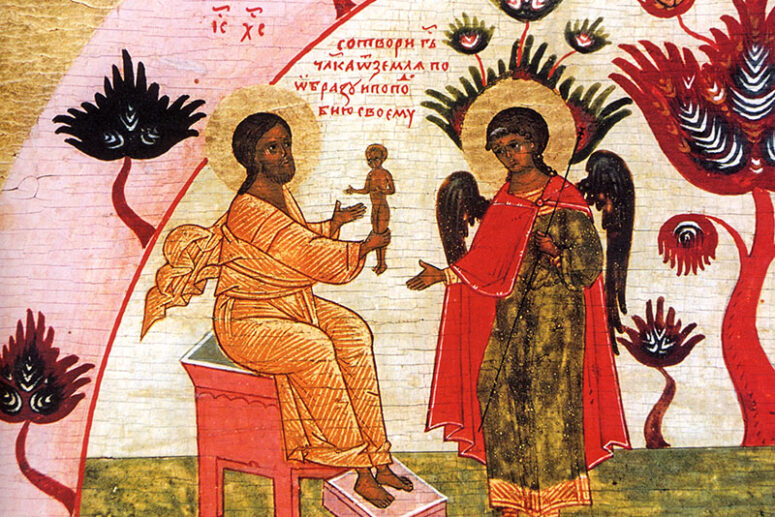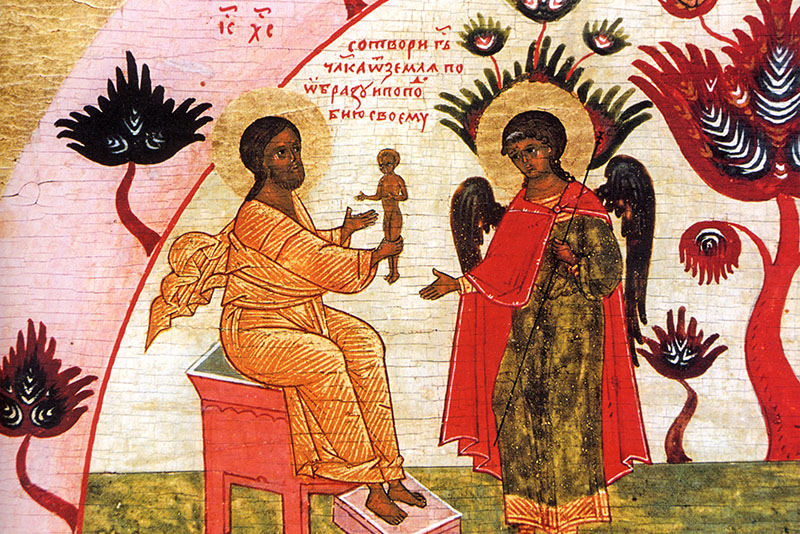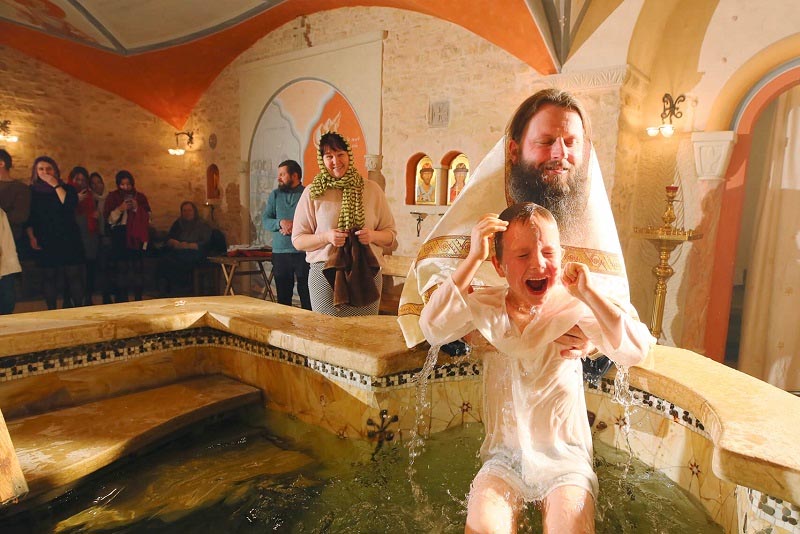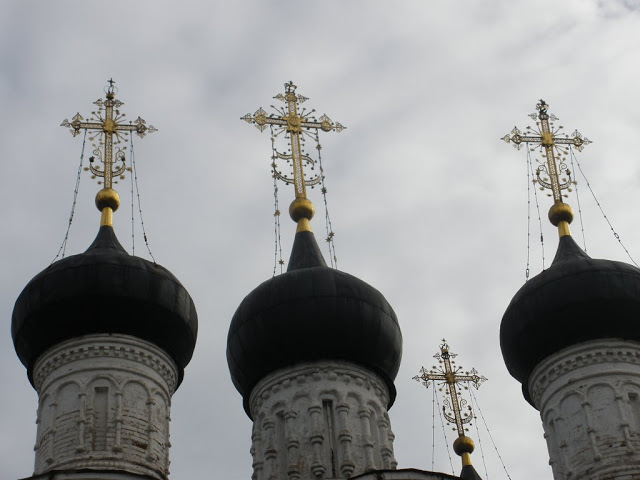
The Scripture teaches us that God created man in His image: “in the image of God He created him” (Genesis 1:27). But what constitutes the image of God in man? If God is spirit (John 4:24), was the human body also created in His image? Or is the image of God found only in the soul? Let us look deeper into these questions.
Before we begin: Tripartite and bipartite views of human nature
The tripartite view assumes the unity of the body, soul and spirit. The capabilities of the soul include the ability to think, feel emotion, appreciate beauty and be creative. The spirit, in turn, gives us our conscience and our fear of God; it also draws us towards Him. In this view, man’s psychic, sensory and rational faculties derive from the soul. In the bipartite view, man is the duality of the body and soul or spirit, with both terms used interchangeably.
Among the Holy Fathers, we find advocates of both views of human nature. They are not contradictory, and neither of them is doctrinal. Moreover, the Church has no doctrine on the composition of human nature. Therefore, we may prefer any view – bipartite or tripartite – that suits a particular context. In this text, we interpret the soul and spirit as synonymous.
The soul
If God is bodiless, was man’s body – tangible, prone to disease and belonging to the male or female gender – also created in His image? In one view, these qualities of the body rule out its likeness to the bodiless and genderless God.
Unlike the body, the human soul is not subject to decay; it is immortal, intangible and invisible, intelligent, loving and creative. Therefore, it is far easier to see the image of God in the soul than in the body.
Many fathers of the Church believed that only the soul and its capabilities were created in the image of God. They reflected on God’s image without mentioning the body altogether.
In his exposition of Orthodoxy, Saint John Damascene wrote: “The phrase “after His image” refers to the side of his nature which consists of mind and free will” (St. John Damascene. An Exposition of the Orthodox Faith, Book II, Chapter XII).
“Some have come to equate man’s creation in the image of God with reason and free will, and others as supremacy and ultimate power, as God’s creation may reflect the image of His creator in both” (St. Photius of Constantinople. Amphilochia, Treatise 36).
St. Gregory the Theologian explained the fundamental difference between body and soul as follows: “I have a two-part nature. My body was created from the earth, and therefore is subordinate to the flesh consubstantial to it. My soul has the breath of God and desires a better life of heavenly beings (“A discourse on the worthlessness of the outer man and the futility of the present”).
St. Theophan the Recluse is unequivocal: “The image and likeness of God do not pertain to the body, but to the soul. The image of God is present in the essence of the soul” (“The Spiritual Life: Selected Teachings”).
This position is also common among authors of textbooks on the Orthodox faith. In his textbook on dogmatic theology, Protopresbyter Michael Pomazansky writes: “To find the image of God, one must first look to the soul, and not to the body. By His nature, God is the purest Spirit, without a body or any material form. Therefore, the notion of God’s image may apply only to the immaterial soul: many of the fathers of the Church adhere to this view.”
Likewise, Archpriest Seraphim Slobodsky writes in his textbook on scripture knowledge that the image of God is present in the capacities and powers of the soul.
But how do these agree with the Scripture that teaches that man was created in the image of God? Does not the scripture text refer to the whole man, not his soul or any other part of his person? No one part can be equated to the whole and no whole to its part. One cannot reduce a man to the soul, and the soul is not the same as a man.
The whole person
The view that the image of God resides in the whole person – the body and the soul – has been less common, but it has had its eloquent proponents. Saint Irenaeus of Lyons, a second-century Holy Martyr, wrote: “the perfect man consists in the comingling and union of the soul receiving the spirit of the Father, and the admixture of that fleshly nature which was moulded after the image of God.” (“Against Heresies”, book 5, chapter 6, Paragraph 1).
The comparison between the capabilities of the soul and the powers of God was unconvincing to St. Epiphanius of Cyprus. He taught that the soul still could not be equated to the image of God, despite its immortality, invisibility and all the other properties. God is boundless, omniscient and all-powerful, while the soul is locked in the body, and thus had limited powers. Therefore, wrote Saint Epiphanius, locating the image of God in some part of the person, rather than the whole person, was an act of ignorance. According to him, the image of God is the whole human person.
The incarnation of Christ and His deification opens a new perspective on the human body. Christ resurrected in the same body in which he lived on earth. However, it transformed and was filled with the spirit to the extent that His disciples could not recognise Him and took him for a spirit (See Luke 24:36-37).
The bodies of the ascetics who achieved deification during their lifetimes, remained incorrupt after their death, like the body of Christ. As this example shows, both the body and the soul can partake of the Divine Nature.
We achieve theosis by growing in the likeness of God. If we can be like God in the soul and body, then the body must also be a part of God’s image, for how can the body attain the likeness of God without participating in His image?
St. Irenaeus wrote that Adam was created in the image of Christ by the foreknowledge of God (Proof of the Apostolic Sermon, 2). Likewise, St. Theodore of Studion wrote: “While on earth, He presented himself in the mind of Adam, whom the blessed Paul called the messenger of the future” (“Against Iconoclasts” chapter 3). Finally, St. Nicholas Cabasilas called Christ the first image of God-created people. (“Seven discourses on life in Christ, 6). Therefore, even though God is a spirit (John 4:24), it was still possible for the human body to have been created in the image of the Divine Body.
Overall, the disregard for the human body – an idea encountered from time to time in the writings of some Orthodox authors – was common in some schools of Hellenistic philosophy. It was then inherited by the Gnostic sects, which the Orthodox Church actively opposed. For the Gnostics, the body was the prison of the soul, as the world was for the human person.
The Christian teaching on the human body was different. In his epistle to the Corinthians, the Apostle Paul wrote: “Do you not know that your body is the temple of the Holy Spirit who is in you, whom you have from God, and you are not your own?” (1 Corinthians 6:19).
Finding the image of God in the person, not in the nature
The twentieth-century theologian V. N. Lossky believed that we should look for the image of God in the person, not in a nature. The Divine Person embraced human nature fully and without reservation, which must suggest the likeness of the human and divine persons.
In Lossky’s reasoning, because the person of Christ did not constitute the divine or human nature, but stood above the human person, the latter could not be reduced to a nature, and thus the image of God should not be sought therein.
Conclusion
So where in human nature do we find the image of God? That is still an open question. Theologians have offered multiple theories but all agreed on the unknowability of God’s image as a mystery of God’s creation.
Regarding the unknowability of the image, Lossky wrote: “The image is unknowable, because, as a reflection of the fullness of the Original person, it must also possess His unknowability. Therefore it is undeterminable what constitutes the image of God in man.”
This thought is consistent with the observation of St Epiphanius – cited earlier in this text – regarding the impossibility of knowing which part of human nature has the image of God.
Yet the Bible still teaches us that man was made in the image of God. It is the truth of God, even though we have not been able to comprehend it fully. Yet the people who strive to live in piety and righteousness in the likeness of God show the world His glorious image.
Read also:
Where Does Orthodoxy End and Heresy Starts?
Degrees of Acceptance of Theological Statements by the Church




God created man in His image and likeness in order that He could incarnate in that image and likeness of man.
How then can we deny the body its part in the image of God?
In the Eschaton God will be all in all embodied in Christ, the faithful of the Body of Christ.
P.S. – Losski should have considered that we know of God all that He revealed to us, and it’s a lot. We know that much about the image too.
As it’s’ written here, St. Irenaeus wrote that Adam was created in the image of Christ by the foreknowledge of God (Proof of the Apostolic Sermon, 2). Jesus Himself affirms the same truth:
“Jesus saith to him: Have I been so long a time with you; and have you not known me? Philip, he that seeth me seeth the Father also. How sayest thou, shew us the Father?”
[John 14:9]